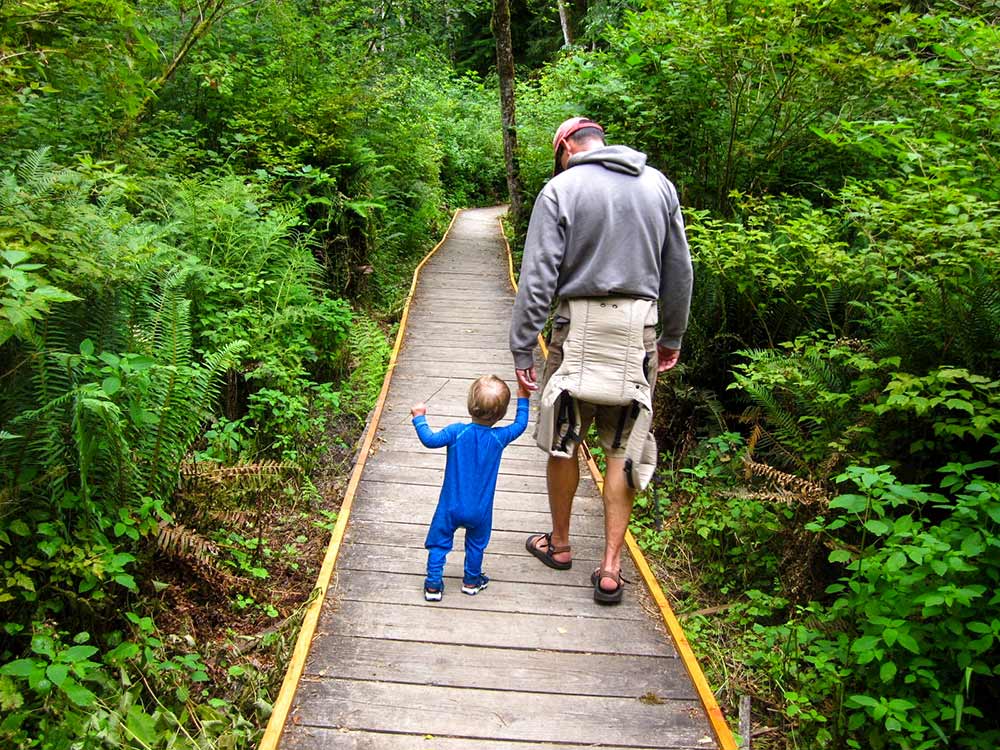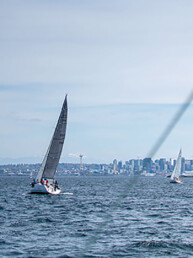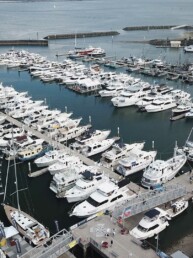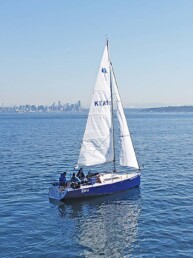Fall means new sailing adventures await
With Yahtzee in a full sprint southward down Padilla Bay, I sat to leeward, looked up at the jib, and gave a few cranks on the winch. Leaning back against the rail, I was glad that just days before, Jill and I had bent on that smaller headsail, which was perfect for these blustery conditions. It was one of the first big blows of the fall, and the sun dropping behind Anacortes created splashes of yellows, oranges, and reds that made for a perfectly autumnal end to the day while approaching Cap Sante Marina.
Fall is one of my favorite seasons to cruise in the Pacific Northwest. Sure, the days are getting shorter, cooler, wetter, and windier, but that’s just it—it’s immensely rewarding to watch the change of seasons from the water. The green of summer hangs on as long as it can until a cornucopia of colors dissent and start popping when the time is right. Stronger breezes mean more opportunity for sailing and truncated days move meals and games from the cockpit to the coziness of your boat’s cabin.
In typical years, any post-Labor-Day cruising typically means fewer crowds; and reduced traffic brings a host of opportunities for seeking solitude. This year, finding a new “normal” in this pandemic environment will likely be different, but we hope you’ll (responsibly) get out for some autumn cruising. Here are a few tips and some of our favorite places to visit when summer fades into fall.
THREE FALL CRUISING TIPS
Service your heater early: Having a working heater is essential. When the days—and especially nights—start to turn cooler, your crew will be much more comfortable and, therefore, happy if they’re warm. It’s a lesson I learned the hard way.
After a particularly warm and spectacular summer of cruising up to Desolation Sound and back, we settled into fall cruising around the San Juan Islands. When that first cool night came and I lit our diesel floor-mounted heater, it flamed out, while at the same time belching soot on the deck. Turned out, the fuel inlet at the bottom of the heater had become blocked, and it took more work than I had hoped to get it cleaned and running smoothly again. The crew was less than pleased.
Trying to avoid that same fate again the next year, I decided to complete a full list of maintenance items and a test run on the heater the following summer. That’s right, before it got cold…not after. Unfortunately, I chose an unseasonably warm day to do this and I can tell you that testing a diesel heater when it’s 80 degrees is not much more pleasant than having a broken one when the temperature is half of that. But, the temporary discomfort paid off when it came time to fire it up on that first chilly fall day and it worked flawlessly. Happy crew!
No matter what type of heating unit you have, follow the manual and go through each part of the system and then give it a good test before fall sets in. Or, at the very least, run it a few times over the summer to make sure it’s still working properly during the change of seasons.
Get the boat ready for more wind: During the summer when there is typically less breeze, it’s easy to get lulled into a sense of sailing complacency. We almost never need a reef in the main and sail with large headsails and flying sails during the peak season. But with fall comes more wind, as lows start to spin off the Pacific Ocean from the south, and sailors can easily get caught with too much canvas up.
Whether it was fall in Alaska or in Puget Sound, our move was always to swap out our large 135% genoa to a more manageable 100% jib as summer waned. We also took the time to practice rigging and sailing with our staysail—which we never needed in the summer—so we wouldn’t be fumbling around on deck with cold hands trying to get it flying as the wind picked up. And making sure our mainsail reefing setups and procedures were running smoothly was vital.
Doing this allowed us to sail from anchorage to anchorage or port to port more comfortably in the heavier winds of autumn. The appropriate suit of sails is a lot like being decked out in the proper foulies for rough weather, with increases in safety, comfort, and enjoyment.
Be confident in your ground tackle: It was a late fall evening, nipping on the heels of winter, when the wind began funneling off the Strait of Juan de Fuca into Garrison and Westcott Bays in gusty waves. Anchored just east of Bell Point and close to shore in Westcott Bay, I periodically looked out of Yahtzee’s cabin windows at landmarks and ranges I’d chosen. Again and again, our anchor held.
That hadn’t been the case about a month earlier when we dragged in one of the first big blows of the season. It’s a longer story than I have room for here, but suffice it to say, the experience prompted us to ditch the old Bruce anchor that came with the boat in favor of a more modern design with superior holding characteristics.
The bottom line was that we just weren’t confident in that Bruce, and confidence in your gear is of utmost importance, especially when it’s safely holding your home and family during one of the windiest times of the year.
For a more in-depth look at preparing your ground tackle, check out Alex Wilken’s column in the August 2020 issue of 48° North, “Getting Your Anchor Ready”. Following on those tips, here are a few of the keys: Make sure you have a reliable way to raise and lower your chain, rope rode, and anchor. Put “service windlass” on your to-do list and go through each link in the chain and every shackle to ensure corrosion isn’t becoming too big an issue. Have your ground tackle secured to the boat and consider having at least one spare anchor that is easy to deploy. Your anchor and chain is a tool, and an important one at that. Take care of it, gain confidence in using it, and it will take care of you.
FAVORITE FALL ANCHORAGES
Windier, cooler, and wetter weather shouldn’t keep you from getting out and enjoying some of the Salish Sea’s spectacular anchorages. Once you have your boat set for the conditions, here are a few favorites.
Chuckanut Bay, North and South Anchorages
Mariners from Bellingham and Anacortes are well aware of these beautiful anchorages that sit below Chuckanut Mountain, but I’m not sure that many other folks are. After all, the nearby San Juan Islands seem to collect most cruisers that are on a schedule, which leaves other off-the-beaten-path locales a bit more open. No matter what time of year it is, Chuckanut Bay is a lovely spot to stop for a night or two, but fall is particularly good and protection can be found from the north or south.
If you’re looking to take cover from a big southerly, the southwest corner of the bay is about as perfect as it gets. Here, pint-sized Pleasant Bay is flanked by a nearly sheer shoreline with private homes nestled amongst the trees. Depths are moderate and we anchored here numerous times in about 30 feet. Prevailing winds are typically out of the southwest and we sat through a blow of about 35 to 40 knots one night without noticing it much. One thing to note is that all shorelines are private. But even though you can’t stretch your legs ashore, we had fun paddling around the perimeter of the coves. To go ashore, head north…
At the north end of Chuckanut Bay you won’t find perfect protection from strong winds, but it’s still pretty good. You can drop your hook up in the northerly corners in about 25 to 40 feet and the nearby train trestle will greatly reduce fetch. (The sound of the train isn’t much of an annoyance.) Also, if you want to anchor here in a moderate southerly you can tuck all the way up to the western shoreline north of the charted rock to gain some relief.
In this section of Chuckanut Bay there are two spots to go ashore. Take your dinghy or kayak under the bridge at high tide and head towards the northeast corner of the bay. There is a public park here to land your craft and from there you can walk up the road to Chuckanut Drive. Just be sure to head back out before the tide drops or you’re stuck—and that is some sticky, icky mud.
The other place to go ashore is at Teddy Bear Cove Park where you can land your tender on the small beach near a set of wooden stairs. The point that juts out into the bay is covered in twisted Madrona trees and the rocks are fun to poke around in. From here, you can hike ‘til your heart’s content. A maintained trail leads across the railroad tracks and then towards Bellingham or up Chuckanut Mountain, which affords sweeping views of the San Juan Islands.
 Tolmie State Park, South Sound
Tolmie State Park, South Sound
Named for Dr. William Frazer Tolmie who spent 16 years with the Hudson Bay Company at nearby Fort Nisqually (which, according to The Archeological Conservancy, was technically a trading post not a fort) in the mid-1800s as a physician, surgeon, botanist and fur trader, Tolmie State Park was a favorite during a swing through south Puget Sound one fall.
Situated on the southwest side of Nisqually Reach, Tolmie State Park has five mooring buoys and ample room for anchorage. We picked up a buoy and were the only boat visiting the park over the two days we were there. Ashore, we found gorgeous hiking trails, tree-lined boardwalks, a large beach and, due to its close proximity to Olympia, picnic shelters for parties of up to 50 people (not in 2020, of course). There were very few people at the park when we visited, but I bet it would be quite full on a beautiful summer weekend. Ah, the benefits of fall cruising!
If you choose to anchor here, take care to avoid the large tidal flat that extends out from the park. And if a strong northerly is forecast, it would be wise to find anchorage elsewhere. Other than that, Tolmie is a quiet place to while away a couple days.
West Sound, Orcas Island
We’ve anchored all over West Sound throughout our time in the San Juan Islands, and for some reason found ourselves there on several occasions during the fall. Our preference has been to use reciprocal moorage on the pier at Orcas Island Yacht Club so we could easily get off the boat to take a walk on the road or so the boys could throw rocks in the water and play on the adjacent beach. But, it’s the quiet anchorages that have kept us coming back.
Starting in the southwest corner of the bay, tranquil anchorage can be found near Double Island and Alegria Island. To the northwest of Double Island, we tucked into a spot labeled on Navionics as “No Name Bay” and enjoyed a peaceful evening watching birds fly in and out of the trees and a bald eagle catch a meal. Just south of that, between Orcas Island to the west and Alegria Island to the east, you can swing all by yourself with very similar views. Note that both these spots do not have shore access and it’s not advisable to cut between Double Island and Orcas unless you have a very shallow draft.
At the head of West Sound to the north is Skull Island State Park in Massacre Bay. Sounds ominous, I know, but it’s a beautiful place to spend a night or three. Skull Island is undeveloped, and we enjoyed paddling and rowing around its shoreline and letting the boys burn off some energy ashore. Reasonable anchorage can be found to the west of the island or to the north. Just beware of rocky reefs to the north. For visiting in the fall, it should be noted that you don’t want to get caught here in the north end of the bay in an unexpected southerly, because it will not be comfortable.
_____________________
As summer winds down, instead of mothballing your boat, make a fall cruising to-do list and chart some new voyages. Yes, it might seem more challenging than high summer cruising, and it likely is. Yet, in our experience, it has always been an adventure worth taking.
Andy Cross
Andy Cross is the editor of 48° North. After years cruising the Pacific Northwest and Alaska with his family aboard their Grand Soleil 39, Yahtzee, they sailed south and are currently in the Caribbean Sea. You can follow their adventures at SailingYahtzee.com.






